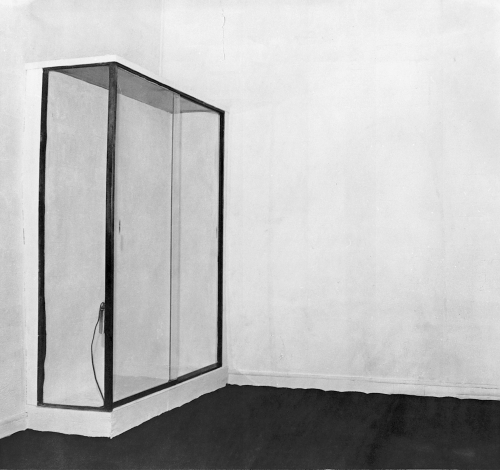Suaire de Mondo Cane
Recent Acquisition: Yves Klein, Suaire de Mondo Cane (Mondo Cane Shroud), 1961.
By Philippe Vergne, Jan 1, 2004.
Half shaman, half showman, a judo champion who “leapt into the void,” a mystic devoted to Saint Rita and self-identified as the painter of space who plotted an ultramarine blue revolution, an architect who dreamed of walls of fire and roofs of air, Yves Klein took the European art scene by storm through a career that barely lasted eight years (1954–1962). After that, it was impossible to look at painting, sculpture, photography, architecture, and music the same way, so intense was Klein’s enthusiasm for experimentation and so far beyond the canonical disciplines was his art.
A few months ago, seated in Yves Klein’s chair, contemplating the walls that he faced every day, touching the doorknobs he grasped, inhaling the air he breathed with the other members of the Nouveau Réalisme group, there in his apartment/studio on Paris’ rue Campagne Première, Daniel Moquay, head of the estate, unfolded in front of my eyes one of the last Anthropometries that Klein produced, Mondo Cane Shroud (1961). Realized in the privacy of his studio or during performances, Anthropometrise are shroudlike paintings that the artist conceived by covering the bodies of nude female models—his “living brushes”—with ultramarine blue paint, which he named and patented as International Klein Blue (IKB). He then instructed these living brushes to produce body prints, radically challenging painting by conciliating it with performance.
The beauty of Mondo Cane Shroud is its drama. Commissioned to be featured in Gualtiero Jacopetti’s film Mondo Cane (1962), the work was realized in front of a camera, through a large sheet of glass, with the artist’s mistaken belief that the filmmaker would do for him what Hans Namuth did for Jackson Pollock, what Henri-Georges Clouzot did for Picasso. Klein could not reconcile himself to the rude awareness that Mondo Cane was the first global exploitation film—a “shockumentary”—abusing his work dedicated to spiritual perceptions of the world. Publicly humiliated at the film’s premiere at the Cannes Film Festival in 1962, he never recovered from the shock and died a few weeks later of a heart attack. Mondo Cane put an end to Klein’s blue revolution and Mondo Cane Shroud became the ethereal shroud of the artist himself. The Walker’s acquisition, which occurred after nearly eight years of searching, of this marvelous painting and accompanying wooden tub, encrusted with the IKB in which the models bathed, brings together the history of film, performance, and painting.


